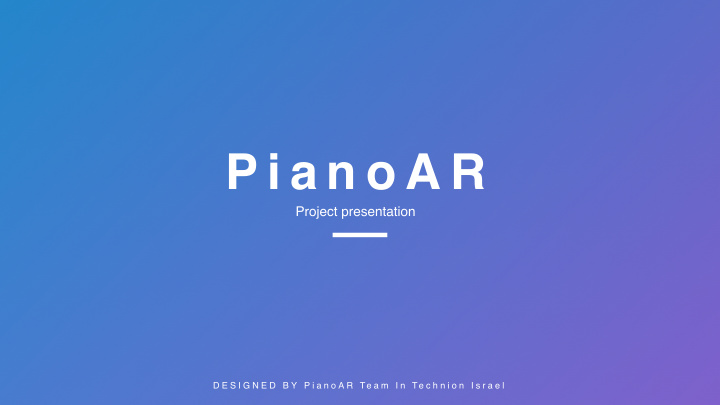



P i a n o A R Project presentation D E S I G N E D B Y P i a n o A R Te a m I n Te c h n i o n I s r a e l
� 2 Meet Our Team PianoAR Gal Shalom, Ariel In y, Alex Bondar Bachelor Computer Science Students, Technion ,Institute of Technology, Israel
� 3 Goals PianoAR Use an AR application to teach how to play piano Using Unity as a platform for developing MR, and Microsoft Hololens v1 as a AR device Primary Objectives 1. Easy to use 2. Accurate piano recognition 3. Lite weight key-press detection 4. Positive feedback for playing 5. Intuitive UI
� 4 Features PianoAR Piano Keyboard Detection Voice Command Interface Key Press Detection Multiple songs to learn Interactive feedback Useable on any piano
� 5 Gameplay PianoAR Keyboard Calibration Freestyle Play Learn “Mary had a little lamb” Main menu Piano Recognition Learn “Twinkle, twinkle , little star”
� 6 Main Menu PianoAR Interactive Menu The menu contains buttons to select the desired option. The menu will tag along the user and includes voice command interface. Challenges 1. How to do a tag along menu 2. Easy to use menu 3. Using the menu without head movement 4. Interact with buttons through hand gestures
� 7 Piano Recognition PianoAR Image Processing recognition The recognition of the piano keyboard using OpenCV library, using linear operations of image processing. After that, Placing virtual piano model on top the real piano. Challenges 1. Learning image processing 2. Build Piano 3D model in Unity 3. Recognition of piano keyboard, without any assumptions on the piano 4. Transforming 2D coordinates to 3D coordinates 5. Light resource algorithm for piano recognition 6. Hololens weak processing power
� 8 Keyboard Calibration PianoAR Keys Calibration Under the assumption, the user won’t move this head. We calibrate the middle octave of the keyboard to be detected by the application when pressed by the used. Challenges 1. Learning image processing 2. Calibration and detection method while keeping it as simple as possible. 3. Few limitations as possible on the user 4. Hololens weak processing power
Finger Recognition � 9 Demo PianoAR
� 10 Freestyle play PianoAR Interactive playing The application will color in yellow the key that is pressed by the user as a feedback. Challenges 1. Detection of the pressed key 2. Few limitations as possible on the user 3. Colouring the correct piano key 4. Hololens weak processing power
� 11 Song learning PianoAR Interactive learning Under the assumption, the user won’t move this head. We mark the current key to be pressed by the user, and give feedback according the user correctness. Green for correct pressing, Yellow for need to be pressed & Red for wrong key. Challenges 1. Detection of the pressed key 2. Few limitations as possible on the user 3. Colouring the correct piano key 4. Hololens weak processing power 5. Design an intuitive feedback 6. FSM for every song
� 12 Development Process PianoAR 3D Modeling Keyboard Calibratio Image Processing Finger Detection
� 13 Demo PianoAR
� 14 Comments & Questions PianoAR
Recommend
More recommend